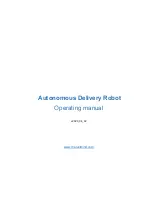
91
6.
Safety Functions
6.1
Introduction
Robot’s from Doosan Robotics uses various safety-rated monitoring and safety-related electrical
interfaces to protect users and devices, and this allows the integration of other devices and additional
protection devices. The performance of each safety-rated monitoring and interface satisfies Category
3, Performance Level d(PL d) defined by ISO 13849-1 and Hardware Fault Tolerance 1, Safety
Integrity Level 2 (SIL 2) defined by IEC 62061.
Note
Work cells must be set using safety functions and the interface according to the risk
assessment performed on the corresponding robot application by the system integrator, and
refer to this manual for information required for this.
If the safety systems of the robot detect system defects such as hardware defects including
emergency stop circuit shortage, position sensor damage or control communication error, stop
category 0 is immediately initiated. Meanwhile, if the safety systems of the robot detect
violations during safety monitoring, such as pressing the emergency stop switch, protective stop
signal input, detection of external impact, or physical parameters (robot position, speed,
momentum) exceeding set parameters, the system stops the robot using the mode set to the
stop mode setting in the safety setting menu. (select one from stop category 0, 1, 2)
In special cases (collision detection, TCP Force Violation), a special mode that stops the robot
after accepting the external force for 0.25 seconds from the time of event occurrence can be
used to avoid clamping situations where a person’s limbs are jammed between the fixed
jig/workpiece and the robot. (RS1 stop mode)
For information on time and stopping distance from the moment the above error or violation
occurs until the robot comes to a complete stop, refer to
Annex C Stop Distance and Stop
. This time must be considered as part of the risk assessment performed by the system
integrator.
The safety setting menu can set various safety functions to limit the movement of joints, robot
and TCP. Here, TCP means the location of the output flange center point added by the TCP
offset.
Summary of Contents for H2017
Page 1: ...1 Manual Version 2 1 Software Version 2 7 1 ...
Page 29: ...29 2 5 3 Robot operating space M0609 ...
Page 30: ...Doosan Robotics Installation Manual v2 1 30 ...
Page 31: ...31 M0617 ...
Page 32: ...Doosan Robotics Installation Manual v2 1 32 ...
Page 33: ...33 M1013 ...
Page 34: ...Doosan Robotics Installation Manual v2 1 34 ...
Page 35: ...35 M1509 ...
Page 36: ...Doosan Robotics Installation Manual v2 1 36 ...
Page 37: ...37 H2017 ...
Page 38: ...Doosan Robotics Installation Manual v2 1 38 ...
Page 39: ...39 H2515 ...
Page 40: ...Doosan Robotics Installation Manual v2 1 40 ...
Page 42: ...Doosan Robotics Installation Manual v2 1 42 M1013 M1509 ...
Page 119: ...119 B 2 Europe Machinery Directive Attestation of Conformity ...
Page 120: ...Doosan Robotics Installation Manual v2 1 120 ...
Page 121: ...121 B 3 Europe EMC Directive Attestation of Conformity ...
Page 122: ...Doosan Robotics Installation Manual v2 1 122 B 4 U S NRTL Certification U S CANADA ...
Page 123: ...123 ...
Page 124: ...Doosan Robotics Installation Manual v2 1 124 B 5 Functional Safety Certification ...
Page 125: ...125 B 6 Voluntary Safety Confirmation Declaration KCs ...
Page 126: ...Doosan Robotics Installation Manual v2 1 126 ...
Page 127: ...127 ...
Page 128: ...Doosan Robotics Installation Manual v2 1 128 ...
Page 129: ...129 ...
Page 130: ...Doosan Robotics Installation Manual v2 1 130 ...
Page 161: ...161 D 1 3 Nameplate and Label ...
Page 176: ...Doosan Robotics Installation Manual v2 1 176 E 1 3 Nameplate and Label ...
Page 190: ...Doosan Robotics Installation Manual v2 1 190 ...
















































